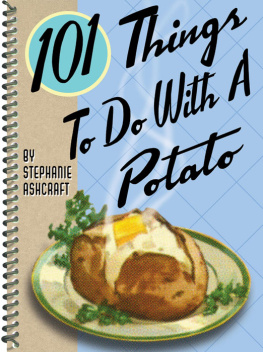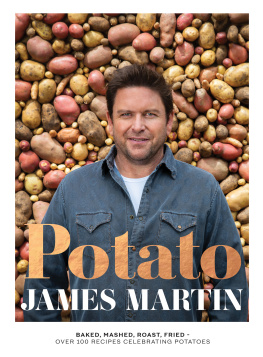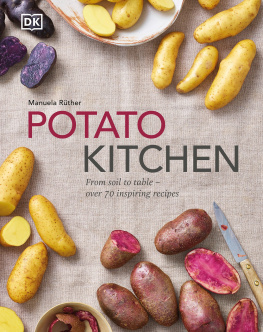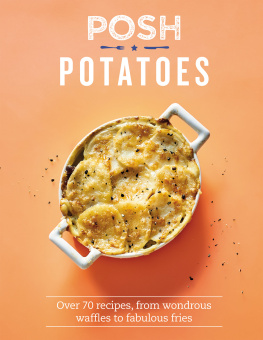Potatoes get a bad rap. Theyre used in popular culture to denote commonness (meat and potatoes) or laziness (couch potato). In everyday culinary use theyre most often found in the form of french fries in fast-food joints, potato chips from local supermarkets, or nondescript heaps of mashed potatoes in buffet lines. But their true nature, both in the kitchen and in our culture, is far more complex and fascinating than it may seem at first blush. How many vegetables have been the subject of international public relations campaigns, or can take credit for population booms, mass migrations, political upheaval, and outright war? The humble potato can take credit for all this, and much more.
This book is my ode to the often-used but underappreciated potato. Its a celebration of the myriad culinary possibilities that are just waiting to be discovered. There are few other vegetables dynamic enough to be roasted, boiled, steamed, baked, fried, or mashed. Multiply this diversity by the dozens of varieties now readily available and the opportunity to create unique dishes truly knows no bounds. The potato is also a passport of sorts, because it allows us to sample foods and flavors from around the world. Its use in America and Europe is well documented, but elegant and exquisite potato dishes can also be found in Africa, India, and the Far East. Not surprisingly, I have found four different variations on the potato pancake alone from opposite corners of the globe. In this book Ive included one of my favorites, which hails from India: a spicy potato cutlet stuffed with ground beef, or kheema. To illustrate the versatility of potatoes, the book is separated into chapters based on the primary flavor profile or texture of the dish. Each section is an exploration of the ways in which the potato can be used. So, though it may start its life in the ground, when combined with the right techniques and ingredients the potato can truly be haute cuisine. I hope youll agree.
Chapter 1
Refreshing
Potato dishes can often turn out greasy or heavy, but that doesnt have to be the case! Whether in starters, salads, or soups, a potato can be a bright and refreshing start to a dinner, or a perfectly balanced lunch that helps keep you going throughout the day. The key to creating light and elegant potato dishes is to select fresh ingredients that accentuate the flavor of the potato without overpowering itcitrus and green vegetables in particular are excellent options. In terms of protein, seafood pairs exquisitely with potatoes, and youll notice that several of the recipes in this chapter make use of tuna, shrimp, and crab.
Vichyssoise
YIELDS 6 SERVINGS
Vichyssoise is a luscious soup made with potatoes, leeks, onions, a dash of cream, and vegetable stock. It was originally created by the French chef Louis Diat in 1917 at the Ritz-Carlton in New York City. He took a classic French potato leek soup from his childhood in Vichy, France, and made it summer-friendly by finishing it with cold milk.
1 pound leeks (white part only)
2 tablespoons leeks (green part only), cut into 112" thick strips
1 tablespoon canola oil
2 tablespoons unsalted butter
1 bay leaf
2 cloves garlic, finely minced
1 pound russet potatoes, peeled and diced
1 quart vegetable stock
2 teaspoons salt
12 teaspoon white pepper, freshly ground
2 cups heavy cream
1 white onion, finely chopped
2 cups milk, cold

Vichyssoise
1. Preparing the leeks: Trim the hairy root but make sure not to cut so high that all the leaves separate. Cut approximately 4" off the fibrous green top of the leek and save it for garnish. Remove a layer or two if the leaves are wilted. Cut the leeks lengthwise into quarters, making sure not to cut all the way through the base, so all the leaves remain attached. Fill a large bowl of water and rinse the leeks, spreading the leaves to remove all the sand and dirt. Wash the leeks again under cold running water; chop finely.
2. Frying the garnish: In a heavy-bottomed small stock pot, heat the canola oil. Add the green part of the leeks. Fry until well-browned, for 34 minutes. Transfer to a paper towel-lined plate, leaving as much oil as possible in the pan. Set the fried leeks aside and let cool.
3. Caramelizing the leeks: In the same pot, add the butter to the remaining oil. Once the butter has melted, add the bay leaf, white onions, and chopped white leeks. Cook for 3 minutes, until fragrant. Add the garlic, stirring occasionally, and let the mixture cook, covered, for another 510 minutes.
4. Making the soup: Add the potatoes to the pot and deglaze with the vegetable stock. You can increase or decrease the quantity of stock, depending on how thick you want the soup. Bring to a full boil and reduce the heat to a simmer. Cook for 2030 minutes. Remove and discard the bay leaf. Working in batches, pour into a blender (or alternatively you can just use an immersion blender directly in the pot) and pulse until very smooth. If you are using a traditional blender, allow the mixture to cool first, or else escaping steam can blow the cover off of the machine. Strain through a mesh strainer and return to the pot. Season with salt and pepper. Add the cream and stir. Bring to a near boil. Stir well. Allow to cool to room temperature for at least 30 minutes.
5. Assembly time: When youre ready to serve, thin the soup with cold milk to cool the soup. Stir well. Ladle the soup into bowls. Garnish with the fried leeks.
D EGLAZING Deglazing is a cooking technique used to free the caramelized deposits of roasted or pan-fried meats and vegetables from the bottom of the pot. Any liquid, from water to vegetable stock or even wine can be used to dissolve these tasty bits and produce a flavorful sauce or soup.













